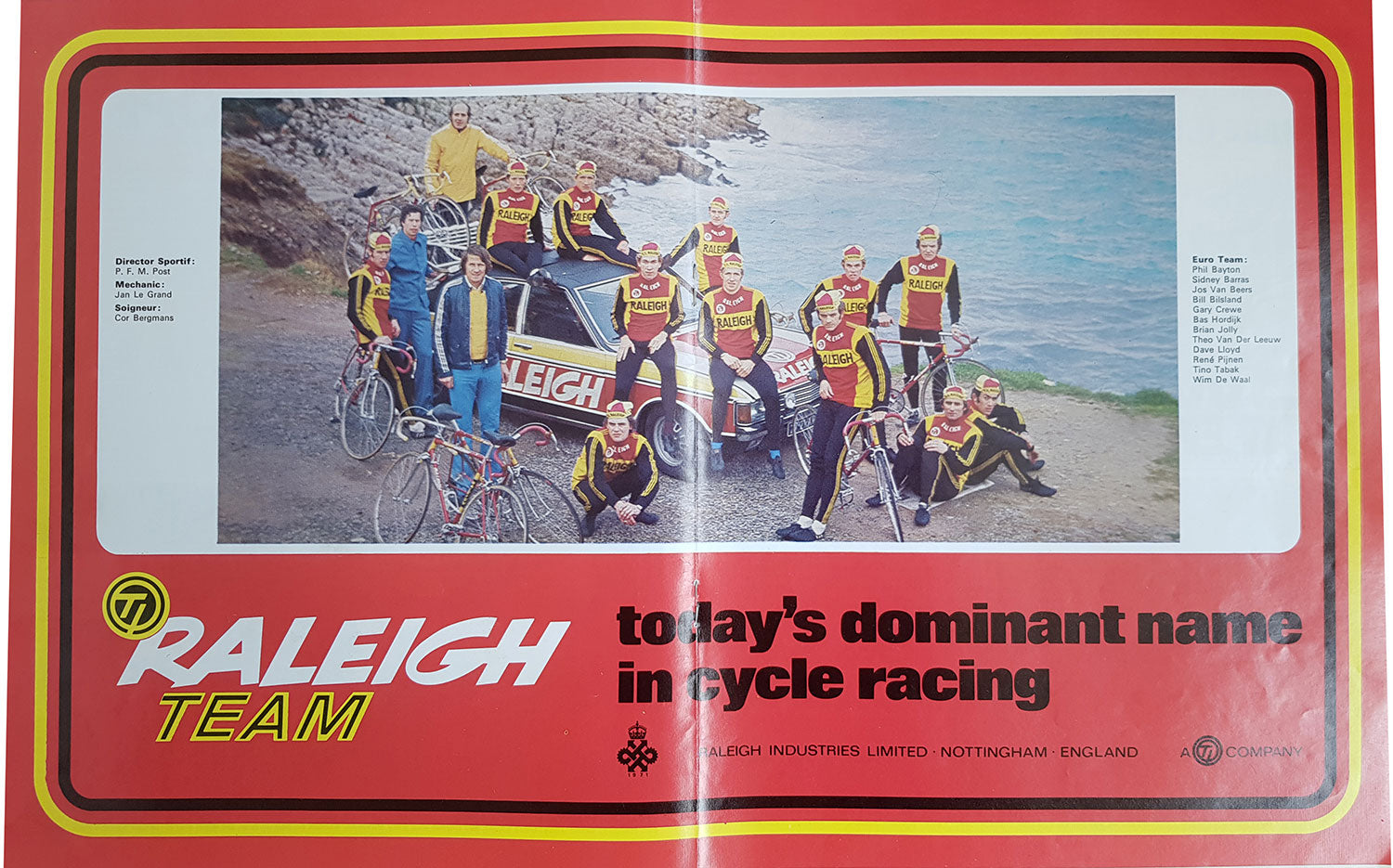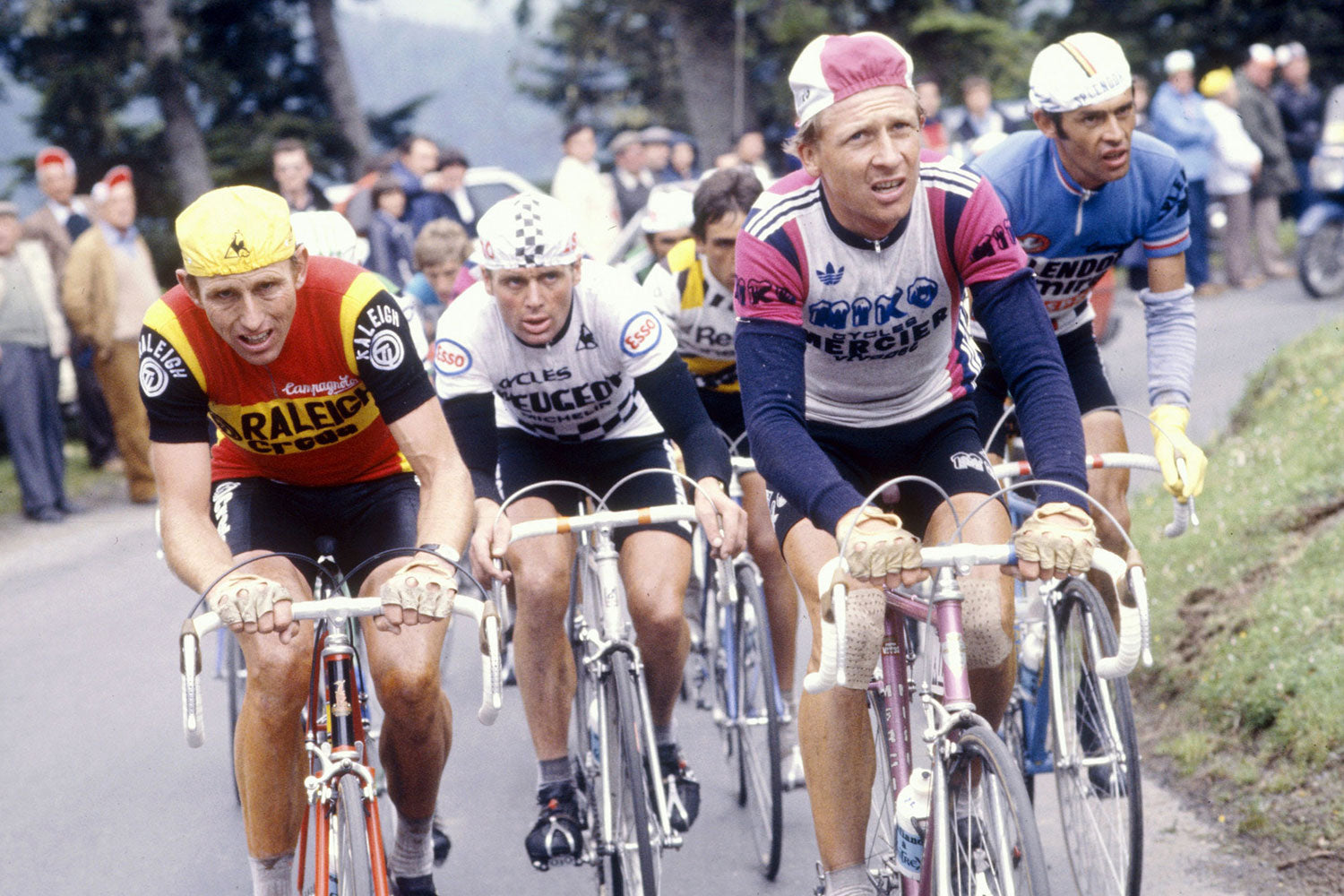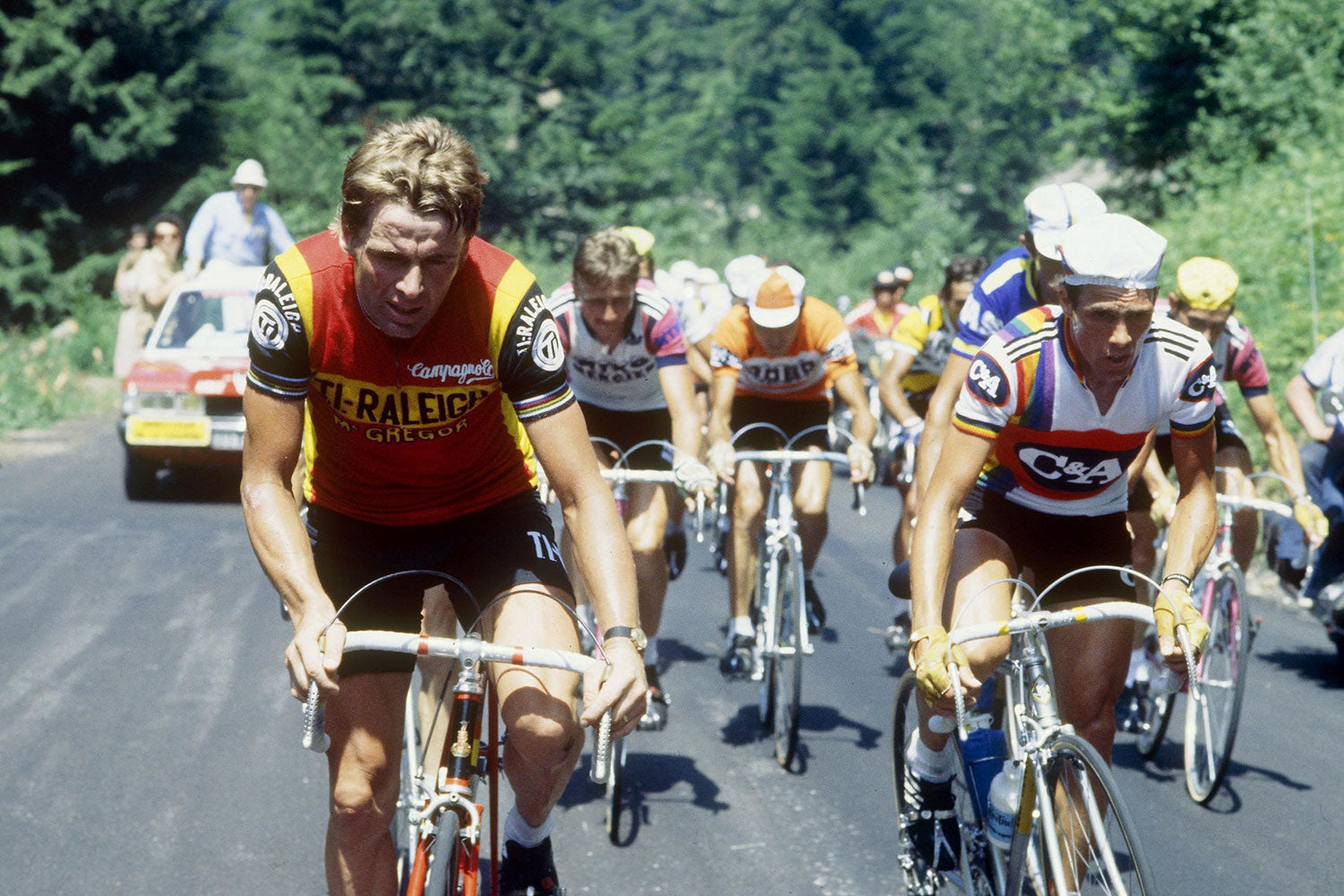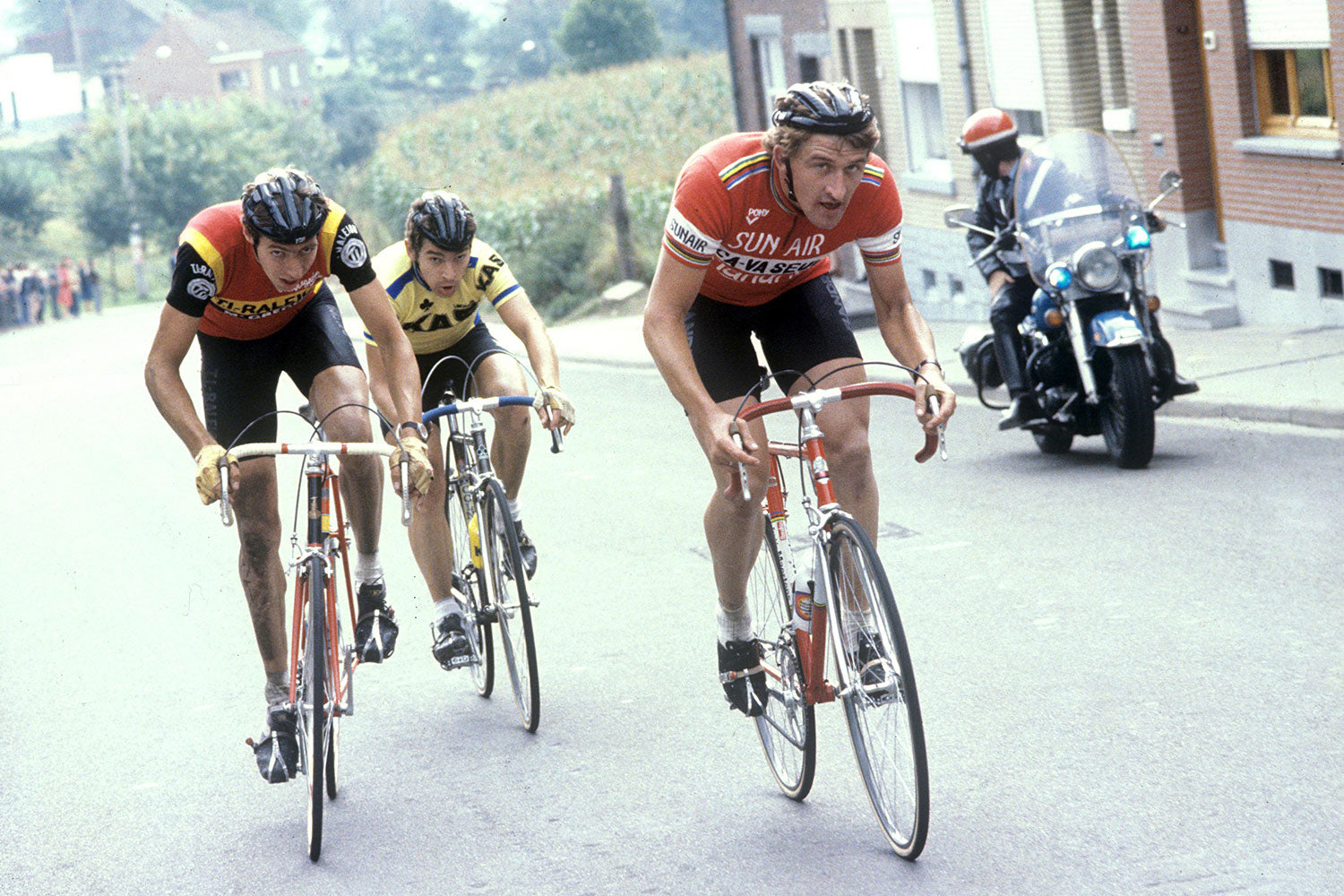QUALITY CYCLING CLOTHING SINCE 1996 - THE UK'S FIRST RETRO MANUFACTURER
QUALITY CYCLING CLOTHING SINCE 1996 - THE UK'S FIRST RETRO MANUFACTURER
RETRO APPAREL
COLLECTIONS
Cycling Clothing
ACCESSORIES
TI Raleigh Cycling Team
July 30, 2019 5 min read

The Raleigh-TI team riding their speciality - the team time trial - at the 1980 Tour de France. The riders are Jan Raas, Johan Van de Velde, Gerrit Knetemann, Paul Wellens, Cees Priem, Bert Oosterbosch, Henk Lubberding and Joop Zoetemelk. Photo credits: Offside / L'Equipe.
Pedr Charlesworth looks into the story behind the TI Raleigh cycling team that combined success on the road and track with the likes of Jan Raas, Peter Post, Joop Zoetemelk, René Pijnen, Frank Hoste and Hennie Kuiper.
In 1964, Peter Post had his finest moment as a rider on two wheels. The first Dutchman to win Paris-Roubaix did so at top speed, triumphing over a cycling’s who’s who of Rik Van Looy, Raymond Poulidor and Rudi Altig, to claim both victory and an unbeaten course record.
Although the route was later changed, it’s incredible that taking home victory at Roubaix after 265km’s averaging 45kmh, may not be Post’s greatest achievement in cycling.
After retiring from the sport in 1972, Post became a director sportif of the newly formed Raleigh-TI team just two years later. Combining respect earnt as a former rider with his corporate aptitude, the Dutch team received a healthy budget and high pedigree of motivated riders to boot.
The names of Hennie Kuiper, Gerrie Knetemann, Jan Raas and Joop Zoetemelk would all ride in the Raleigh red, yellow and black over the years to come. Years in which they produced a series of performances placing them as one of the top teams of the decade under Post’s iron grip.

The TI Raleigh double-page spread magazine advert that featured in International Cycle Sport issue Number 70 (March 1974).
Despite being a Dutch outfit, sponsorship came from the British firm, Raleigh Bicycles and their holding company Tube Investments (TI). The building of the rider’s frames was at Raleigh’s Ilkeston facility; going on to win many a monument, classic and Grand Tour stage.
Notable success from the spring seasons came from the ever-dependable Jan Raas, a rider who asserted his dominance over the team’s lifetime, bringing home a record five Amstel Gold Races (1977,’78,’79,’80,’82) – four of which pedalling British steel for the outfit.
Alongside Raas, top Dutch talent and leadership came in the form of Joop Zoetemelk. After turning professional for Mars-Flandria in 1970, he consistently placed well in the Tour for his subsequent teams – finishing second in his first professional season and wearing yellow for the first time the following year. After almost dying in a horrendous crush during the 1974 Midi Libre - cracking his skull after colliding with an unattended car – Zoetemelk’s Grand Tour performances were more than enough to rouse the interest of Post.

Stage 13 of the 1980 Tour de France - Pau to Bagneres de Luchon. Joop Zoetemelk leads Hennie Kuiper (Peugeot), riding in a bunch with Jean Rene Bernaudeau, Sven Ake Nilsson and Johan de Muynck. Photo credits: Offside / L'Equipe.
Soon he was recruited into the Raleigh ranks for the 1980 season, a key time for the team, as star rider Hennie Kuiper had left to pursue titles with Peugeot. Kuiper had ridden to victory on the Alpe d’huez on two consecutive editions, making him a man to mark closely in the peloton this time around.
The stiffest competition, however, would come from Renault’s star rider and two-time Tour winner - Bernard Hinault. Nicknamed the ‘Badger’, due to his aggressive style of riding, the early stages proved a tough battle for yellow, which had Hinault ahead in the general classification by stage 11. By this point a 33-year old Zoetemelk was riding well, applying serious pressure with a strong ride on the stage’s time trial – closing the gap to 21 seconds with his convincing win. With Hinault feeling the heat, citing issues with an inflamed tendon in his knee, he was eventually forced to abandon after stage 12 much to the disappointment of the French public. In a true ‘Merckxian’ manner, Zoetmelk refused to wear yellow out of respect for Hinault on his first day in the lead, just as the great man had done for Ocaña in the ’71 edition.
As the Tour drew into the business alpine end, Zoetemelk, usually the strongest of climbers, could be seen riding conservatively up the climb to Pra Loup. 3km from the summit, a bizarre incident occurred, where he was knocked to the ground by one his own domestiques after he slipped gears and swerved into his leader. Cuts to his arm and thigh opened up, as did the gap to the summiting peloton in front. Riding now with his usual climbing prowess and high intensity, he was able to bridge the gap, even sprinkling a little panache on the group as he then attacked Kuiper. What was so nearly a calamitous stage for the Dutchman, turned into a 16 second gain on his closest rival and ex-Raleigh rider. After that digging that deep, however, it was unsurprising to see him requiring some strong pacing by the team to keep him in contention the following day, before striking out with the ever-strong Belgian climber – Van Impe – on the third Alpine stage.

Hennie Kuiper and Lucien Van Impe riding in the 1978 Tour de France. Photo Credits: Offside / L'Equipe.
From here Zoetemelk and Raleigh controlled his lead until Paris, dominating the podium with 12 stage victories, seven of which were on the trot. The teams first and only Tour de France victory was one of the most dominating performances in the races’ history, cementing both Zoetemelk’s and Raleigh’s place in cycling folklore. As a rider and a leader, Zoetemelk’s 16 Tour finishes, containing a staggering six second placings alongside his win, are a testament to the longevity and determination of the man who played a crucial part of the team’s 28 stage victories over the years.
Despite the outside speculation that Hinault would remain the de-facto champion be it not for injury, a palmares containing a Tour de France, Vuelta a Espana and World Championship victory drowns the noise questioning the pedigree of this rider. Nevertheless, Jan Raas (who was on an upward trajectory) was soon promoted to the team’s leadership duties after their emphatic victory. The team remained firmly behind Raas in the years to come, until he sadly injured his back and internal organs during an awful crash at the 1984 edition of Milan San Remo, forcing him to retire from racing before moving into management.

Freddy Maertens and Johan Van de Velde riding the 1979 Paris - Brussels. Photo credits: Offside / L'Equipe.
Two heavyweight team directors saw the rise of the inevitable rift in the Raleigh ranks that would ultimately lead to their demise. Seven riders followed Post to his new Panasonic team, whilst six moved with Raas to Kwantum Cycling, which, through its many iterations has become one of this season’s success stories as Jumbo-Visma.
It’s somewhat fitting then that just as Raas rode with Raleigh to great success in their speciality, the team time-trial, Visma took home the honours at this year’s Tour de France in the same discipline. Times change but the teamwork remains, Raleigh’s legacy lives on today, be it through new names, frames and aero bars.

You can buy accurate replicas of the TI Raleigh jerseys, cycling caps and accessories at Prendas Ciclismo by visiting the TI Raleigh collection.
Also in News and articles from Prendas Ciclismo

Prendas' Best-Selling Caps of 2024
January 21, 2025 4 min read
With 2024 in the books, we're looking back at your favourite caps of the year. From cult classic movies to the jungle with a whole lot of Italian flair, check out our best-sellers and grab a new cap!

Vas-y Barry! Hoban wins Ghent-Wevelgem for Gan Mercier Hutchinson
May 15, 2024 8 min read
In an extract from his autobiography, Vas-y Barry, the only British winner of Ghent-Wevelgem, Barry Hoban tells how he won the cobbled classic in 1974, beating Eddy Merckx and the cream of Belgian cycling.

Our Best Selling Caps of 2023
January 15, 2024 4 min read
We know caps here at Prendas Ciclismo, and we know that you love all the styles we have on offer. So every year, we look back at our best-selling cycling caps for the previous year for you to discover a few new styles. Is your favourite cycling cap featured on our list? Read on and see!
Subscribe
Sign up to get the latest on sales, new releases and more …

